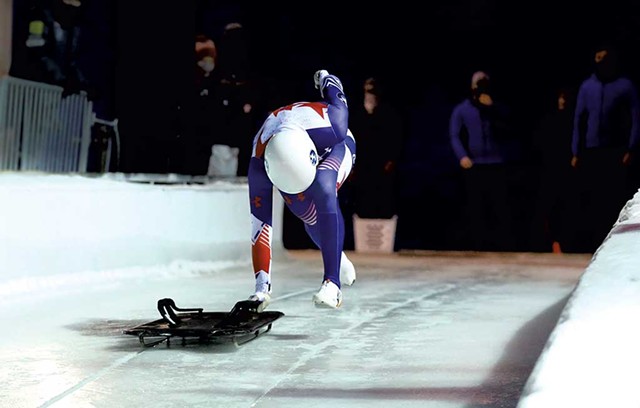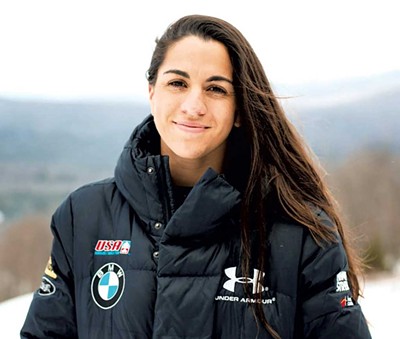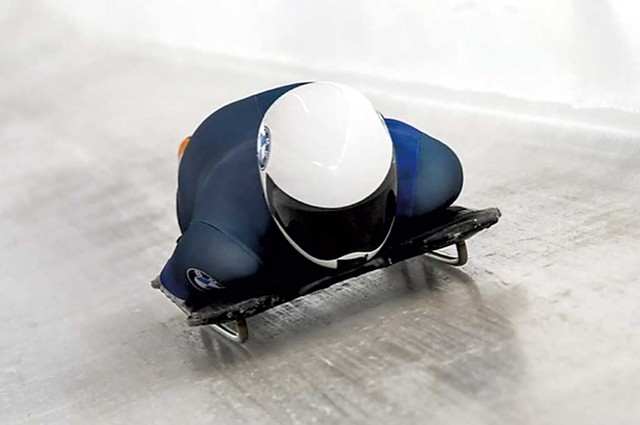
- Courtesy
- Sara Roderick
Of all the sports in the Winter Olympics, few are as terrifying — or aptly named — as skeleton. Similar to luge, the sliding sport requires athletes to race down a steep, frozen track, navigating hairpin turns at extreme speeds while lying on a tiny metal sled with no brakes or built-in steering mechanisms. Also, skeleton racers go down headfirst.
Sara Roderick, a 2015 University of Vermont alum and South Burlington resident, is one of the nation's premier women's skeleton athletes. In March, she won the USA Bobsled/Skeleton National Championships in women's skeleton, and she's currently training with Team USA in hopes of qualifying for the 2026 Winter Olympics. The 30-year-old aims to be ranked among the top 15 women skeleton athletes in the world this year — she's currently unranked after missing most of last season due to injury.
"To win the national championship was really cool and special," Roderick said. "I had some really good runs, became a lot more confident in decision making and just was able to see the bigger picture."

- Courtesy Of Jimmy Reed
- Sara Roderick
As a member of UVM's track team, Roderick excelled in the heptathlon: a combination of 100-meter hurdles, high jump, shot put, the 200-meter dash, long jump, javelin throw and the 800-meter run. It was Roderick's track coach who encouraged her to try skeleton after the two watched one of his former athletes compete in the televised 2014 Winter Olympics in Sochi, Russia. The coach offered Roderick access to the skeleton track in Lake Placid, N.Y., the site of the 1980 Winter Olympics. Taken by the exhilarating ride, she's stuck with the sport ever since.
Roderick's sprinting skills translate well from the track to the ice. At the start of a skeleton run, a racer sprints with one hand pushing their sled for about 50 meters to build momentum before diving on board and bombing down the track. Team USA sliding coach Caleb Smith said Roderick is "one of the fastest starters in the world."
"That gives her that advantage going into curve one," Smith said. Running is "one of her top strengths historically, and over the last few years, she has really started to bring the sliding piece right up there to match it."
Sliding technique often involves simply letting gravity take over, Roderick said. Reaching top speeds of 83 miles per hour on straightaways, she lies face down on the sled as flat as possible to make her body aerodynamic. Around turns, she translates split-second decisions into slight bodily movements in her knees and shoulders to steer.
As many as five Gs of force will pull the sled upward around banked corners, Smith said, so athletes must maneuver the sled to instead glide forward and stay on the track. He compared the pressure athletes feel in their bodies to that experienced by race car drivers and fighter pilots.
Roderick said she's come a long way from her first-ever skeleton run, when she was so nervous that she could feel her heart pounding in her chest. She's learned to manage that anxiety and works with sports psychology consultant Sheila Stawinski of Essex to mentally prepare for races.
"It's not about eliminating fear. It's about recognizing it and managing it," Stawinski said. "And Sara's really gotten very good at that."
While skeleton may seem like a bone-chilling thrill ride, the sport is far safer than most people think, said Smith, who placed second at the Skeleton World Cup in Lake Placid in 2006 before he became a coach. Athletes may get "bumps and bruises," but he said more serious injuries are rare. He added that skeleton is generally considered less dangerous than bobsled or luge due to its more subtle steering and lower-to-the-ground positioning that make turning less risky.
For her part, Roderick said she feels safe during races. While she sustained a head injury last season, she said it was the result of both repetitive strain and a go-kart accident — not a catastrophic skeleton crash.
"Imagine rattling your head when it's bumpy, going 70 miles an hour downhill with a ton of pressure," Roderick said. "Yeah, of course it's gonna hurt. Is it the smartest thing? No, of course not. But it's fun. I think it's a lot on the athlete just being smart and speaking up when you need to."
Coming back from that injury was tough, Roderick said. Her first day back on the track, she could only get the sled to go 30 miles per hour — a far cry from her usual average of around 70.

- Courtesy
- Sara Roderick
But with determination, she was able to bounce back. Roderick said she treats skeleton as a full-time job and trains for about 36 hours per week. That includes strength training, running, spinning on a stationary bike, and mapping out and visualizing races.
Lake Placid is just one of two facilities in the U.S. with skeleton tracks — of only 18 worldwide, according to the International Bobsleigh & Skeleton Federation. Roderick is lucky to be able to train there, but with so many other skeleton, bobsled and luge athletes all waiting on the same track, she only gets about eight minutes on ice per week. That translates to six runs spread across two training days.
There's "tons of work off the ice to help make the most of those eight minutes," Roderick said. "We go through different scenarios of OK, if you enter the curve like this, what are you going to do if this happens? What should your decision be afterward?"
Another big challenge is funding. To support her athletic career, Roderick fundraises, picks up shifts as a server at American Flatbread in Burlington, does data entry at UVM's Orthopedics and Rehabilitation Center, and coaches the South Burlington High School track team in the spring.
Smith said Roderick has a growth mindset that serves her well.
"Sarah is very, very determined. She's also very jovial, and she knows when to laugh and not get too stuck in the mud when things aren't going the right way," he said. "She has all the potential to go to the Olympics and medal."
While Roderick hopes to qualify for the Olympics, she said her goals tend to be more process-oriented than outcome-driven. She said her current focus is staying injury-free as she approaches her first race of the season at Lake Placid in March.
"It's just hustling, working, a lot of credit card debt. But it's definitely worth it to me," Roderick said. "This year I just feel super supported, super healthy, super excited to race."










Comments
Comments are closed.
From 2014-2020, Seven Days allowed readers to comment on all stories posted on our website. While we've appreciated the suggestions and insights, right now Seven Days is prioritizing our core mission — producing high-quality, responsible local journalism — over moderating online debates between readers.
To criticize, correct or praise our reporting, please send us a letter to the editor or send us a tip. We’ll check it out and report the results.
Online comments may return when we have better tech tools for managing them. Thanks for reading.